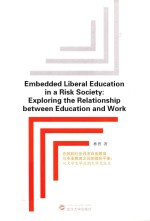

在风险社会寻求自由教育与专业教育之间的微妙平衡 从大学生毕业到大学生就业PDF电子书下载
- 电子书积分:10 积分如何计算积分?
- 作 者:林曾著
- 出 版 社:武汉:武汉大学出版社
- 出版年份:2015
- ISBN:9787307153509
- 页数:215 页
Chapter One Introduction 1
1.1 Objectives of the Book 1
1.2 The University and the New Economy 7
1.3 A"Mass Education"Mandate 8
1.4 The Liberal Education Debate 10
1.5 The Individual's Response 12
1.6 The FOS-Outcomes Model 15
1.7 Significance and Implications of the Study 17
1.7.1 Significance 17
1.7.2 Implications 17
1.8 Delimitation of the Study 18
1.9 Organisation of the Book 19
Chapter Two Field of Study in a Risk Society 21
2.1 Theory of Risk Society 22
2.1.1 Core Concepts of the Theory of Risk Society 22
2.1.2 Characteristics of the Risk 24
2.1.3 Why Do We Feel More Risky? 25
2.1.4 Individualization 26
2.1.4a Logic of Individualization 27
2.1.4b Role Played by Education in the Process of Individualization 28
2.1.4c Implication of Individualization 30
2.1.4d Beyond Linear Progress 31
2.2 The Changing Workplace and Individual Response 33
2.2.1 The Changing Workplace 34
2.2.1a Changing Occupational Structure 34
2.2.1b Changing Nature of the Workplace 35
2.2.1c Declining Work Hours 36
2.2.1d Non-standard Employment 37
2.2.2 Risks and Opportunities 38
2.2.2a Risks 38
2.2.2b Opportunities 44
2.2.3 Individual Response to the New Economy 47
2.2.3a Response Based on Social Structural Positions 48
2.2.3b Response Based on Personal Agency 48
2.2.4 FOS Choice and Policy Implications 50
2.3 The Expansion of Mass Education 51
2.3.1 Mass Education and Modernization 52
2.3.2 Three Waves of Expansion of Mass Public Education 54
2.3.3 Meaning of Mass University Education 57
Chapter Three Historical Perspectives on Liberal and Vocational Education 60
3.1 Plato's Liberal Education 61
3.1.1 Greek Society and its Elite Education 61
3.1.2 Idealist Philosophy 63
3.1.3 From Philosophy to Education 65
3.2 The Origin of Modern Liberal Education 69
3.2.1 The Enlightenment and Modern Liberal Education 69
3.2.2 Romantic Movement and Conservatwe Tradition 71
3.3 Dewey's Progressive Education 72
3.3.1 Framework and Sources 73
3.3.2 Criticism 74
3.4 Contemporary Debates over Liberal Education 75
Chapter Four Data Description and Research Methods 80
4.1 Data Source 80
4.1.1 National Graduate Survey(NGS) 80
4.1.2 Sample Selection and Data Limitations 81
4.1.2.a Sample selection 81
4.1.2.b Data Limitations 82
4.2 Objectives,Research Questions and Research Methods 83
4.2.1 Objectives 83
4.2.2 Research Questions and Research Methods 83
4.3 Case Selection and FOS Classification 88
4.3.1 Case Selection 88
4.3.2 Classification of FOS 89
4.4 Description of Variables 90
4.4.1 Social Structure Variables 90
4.4.2 Agency Variables 92
4.4.3 Outcome Variables 94
4.4.4 Relevance of Education and Work 95
Chapter Five Risk Management and Educational Choice 98
5.1 FOS Choice and LMO 98
5.2 Social Structure,Personal Agency and FOS Choice 101
5.2.1 Logistic Regression 101
5.2.2 Social Structural Position and Educational Choice 105
5.2.3 Pathways of Schooling and Educational Choice 107
5.3 Educational Choice and Strategies of Managing Risks 109
5.3.1 Educational Choice and Coping Strategies 110
5.3.2 Coping Strategies and LMO 112
5.3.2.a Second Major 114
5.3.2.b Co-op Programs 118
5.3.2.c Part Time Studv 121
5.3.2.d Education Upgrading and Recycling 124
5.3.3 Structure and LMO 131
5.3.3.a Gender 131
5.3.3.b Age 134
5.3.3.c Ethnicity 137
5.3.3.d Mother's Education 139
5.3.3.e Father's Education 142
5.3.3.f Region of Origin 145
5.3.3.g Summary 148
5.4 Relevance of Education and Work 149
5.4.1 Underemployment 149
5.4.2 Job-Education Linkage and LMO 152
5.4.3 Educational Choice and Educational Outcomes 162
5.4.4 Employment Skills 164
5.5 Summary 166
Chapter Six Discussion and Conclusion 168
6.1 Conclusion 168
6.1.1 From FOS to LMO 168
6.1.2 Structure,Agency and the Choice of FOS 169
6.1.3 Structure,Agency and LMO 171
6.1.4 The FOS choice and Educational Return 175
6.2 Implications 178
6.3 Embedded Liberal Education in a Risk Society 178
6.3.1 What is an embedded liberal education? 178
6.3.2 Why is the liberal education embedded? 179
6.3.3 How is an embedded liberal education supported? 182
6.4 Future Needed Research 187
Appendix Coding Scheme of Logistic Regressions 189
References 197
- 《大学计算机实验指导及习题解答》曹成志,宋长龙 2019
- 《培智学校义务教育实验教科书教师教学用书 生活适应 二年级 上》人民教育出版社,课程教材研究所,特殊教育课程教材研究中心编著 2019
- 《习近平总书记教育重要论述讲义》本书编写组 2020
- 《大学生心理健康与人生发展》王琳责任编辑;(中国)肖宇 2019
- 《办好人民满意的教育 全国教育满意度调查报告》(中国)中国教育科学研究院 2019
- 《大学英语四级考试全真试题 标准模拟 四级》汪开虎主编 2012
- 《大学英语教学的跨文化交际视角研究与创新发展》许丽云,刘枫,尚利明著 2020
- 《教育学考研应试宝典》徐影主编 2019
- 《语文教育教学实践探索》陈德收 2018
- 《家庭音乐素养教育》刘畅 2018
- 《东西晋演义 话说中华五千年》(明)杨尔曾著 2019
- 《半道拾遗》郭宪曾著 2016
- 《甲子魂归》杨希曾著 2012
- 《票据法概论》谢菊曾著 1930
- 《中国印谱全书》陈师曾著 2013
- 《我国新媒体产业的市场结构、行为与绩效研究》周曾著 2013
- 《中国绘画史》陈师曾著 2013
- 《中国亚非关系史》耿引曾著 2014
- 《中国文化艺术名著丛书 中国绘画史》陈师曾著 2013
- 《中国司法制度》陶汇曾著 1926
- 《大学计算机实验指导及习题解答》曹成志,宋长龙 2019
- 《大学生心理健康与人生发展》王琳责任编辑;(中国)肖宇 2019
- 《大学英语四级考试全真试题 标准模拟 四级》汪开虎主编 2012
- 《大学英语教学的跨文化交际视角研究与创新发展》许丽云,刘枫,尚利明著 2020
- 《复旦大学新闻学院教授学术丛书 新闻实务随想录》刘海贵 2019
- 《大学英语综合教程 1》王佃春,骆敏主编 2015
- 《大学物理简明教程 下 第2版》施卫主编 2020
- 《大学化学实验》李爱勤,侯学会主编 2016
- 《中国十大出版家》王震,贺越明著 1991
- 《近代民营出版机构的英语函授教育 以“商务、中华、开明”函授学校为个案 1915年-1946年版》丁伟 2017
